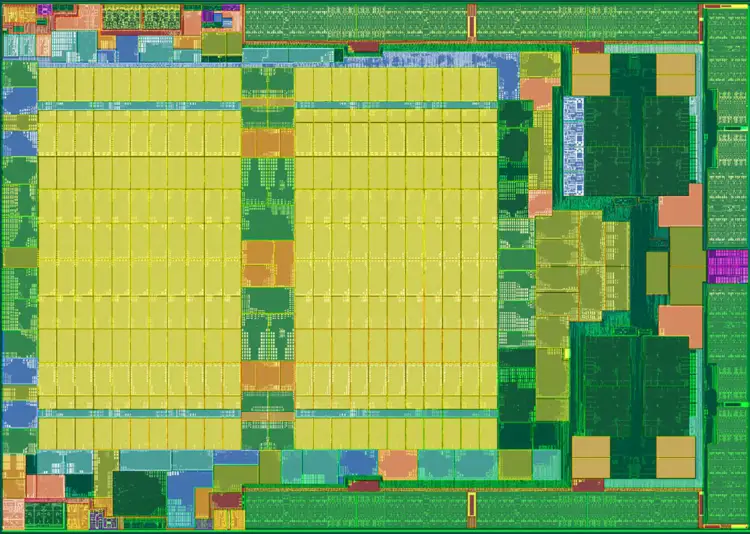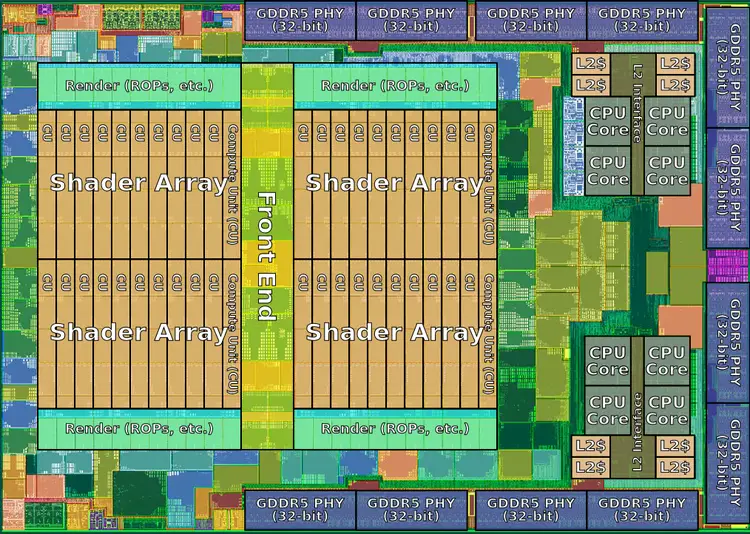(→Graphics) |
(→Graphics) |
||
| Line 63: | Line 63: | ||
== Graphics == | == Graphics == | ||
| + | {| class="wikitable" style="float: right;" | ||
| + | ! colspan="3" | Hardware Accelerated Video Capabilities | ||
| + | |- | ||
| + | ! Codec !! Encode !! Decode | ||
| + | |- | ||
| + | | [[MPEG-4 AVC]] (H.264) || {{tchk|yes|4K @ 60 Hz}} || {{tchk|no}} | ||
| + | |- | ||
| + | | [[HEVC]] (H.265) || {{tchk|yes|4K @ 60 Hz}} || {{tchk|yes|4K @ 60 Hz}} | ||
| + | |- | ||
| + | | [[VP9]] || {{tchk|yes|4K @ 60 Hz}} || {{tchk|no}} | ||
| + | |} | ||
{{main|amd/microarchitectures/arctic islands|l1=Arctic Islands microarchitecture}} | {{main|amd/microarchitectures/arctic islands|l1=Arctic Islands microarchitecture}} | ||
Scorpio Engine feature 40 Compute Units (CUs) based on {{amd|Arctic Islands|l=arch}} (Similar to Polaris, Radeon RX 4xx). This is triple the amount over the original Scorpio Engine. The Compute Units operate at 1,172 MHz, each with 64 32-bit [[floating point]] [[multiply-accumulate]] units. At 1.172 GHz with 128 FLOP/cycle this chip can deliver 6.00064 TFLOPS raw peak performance - over four times previous chips (which were 1.3 and 1.4 TFLOPS). The performance of texture processing has also been increase to 187.5 G bilinear texels/second. Additionally, in each of the four shader arrays, there is one geometry engine for the purpose of doing fixed geometry processing, this is twice previous chip which is capable of 4.688 Giga primitives/second. | Scorpio Engine feature 40 Compute Units (CUs) based on {{amd|Arctic Islands|l=arch}} (Similar to Polaris, Radeon RX 4xx). This is triple the amount over the original Scorpio Engine. The Compute Units operate at 1,172 MHz, each with 64 32-bit [[floating point]] [[multiply-accumulate]] units. At 1.172 GHz with 128 FLOP/cycle this chip can deliver 6.00064 TFLOPS raw peak performance - over four times previous chips (which were 1.3 and 1.4 TFLOPS). The performance of texture processing has also been increase to 187.5 G bilinear texels/second. Additionally, in each of the four shader arrays, there is one geometry engine for the purpose of doing fixed geometry processing, this is twice previous chip which is capable of 4.688 Giga primitives/second. | ||
| Line 75: | Line 86: | ||
<tr><th>Peak Performance</th><td> ~6 TFLOPS (6,000,640,000,000 [[FLOPS]])</td></tr> | <tr><th>Peak Performance</th><td> ~6 TFLOPS (6,000,640,000,000 [[FLOPS]])</td></tr> | ||
</table> | </table> | ||
| − | |||
| − | |||
| − | |||
| − | |||
| − | |||
| − | |||
| − | |||
| − | |||
| − | |||
| − | |||
| − | |||
| − | |||
=== RBs and Memory Subsystem === | === RBs and Memory Subsystem === | ||
Revision as of 17:06, 20 September 2017
Template:mpu Scorpio Engine is a 64-bit octa-core x86 SoC designed by AMD and Microsoft for their Xbox One X. The chip features eight Enhanced Jaguar cores operating at 2.3 GHz and a custom Arctic Islands-based GPU operating at 1.172 GHz. Fabricated on TSMC's 16FF+, this chip supports 12 (24 for Dev) GiB of 12-channel GDDR5-6800 memory.
Contents
Overview
Like the PlayStation 4 and the Xbox One, the Xbox One X is also powered by a chip based on AMD's architectures. The Scorpio Engine most important goal was achieving true 4K gaming performance according to John Sell, a Distinguished Engineer at Microsoft who presented the chip at Hot Chips 29. Fabricated on a TSMC's 16 nm process, the chip contains 7 billion transistors on a 359 mm² die, similar in amount to Nvidia's GTX 1080 and almost the same size as the original Xbox One SoC (which was 363 mm² on a 28 nm process).
Like the original Xbox One SoC, the chip feature eight Jaguar cores. The cores have been lightly enhanced and operate at a higher frequency of 2.3 GHz, but are otherwise mostly identical. It's worth pointing out that AMD has not commercialized a 16 nm Jaguar processor outside of this chip.
Cache
- Main article: Enhanced Jaguar § Cache
|
Cache Organization
Cache is a hardware component containing a relatively small and extremely fast memory designed to speed up the performance of a CPU by preparing ahead of time the data it needs to read from a relatively slower medium such as main memory. The organization and amount of cache can have a large impact on the performance, power consumption, die size, and consequently cost of the IC. Cache is specified by its size, number of sets, associativity, block size, sub-block size, and fetch and write-back policies. Note: All units are in kibibytes and mebibytes. |
|||||||||||||||||||||||||
|
|||||||||||||||||||||||||
Memory controller
|
Integrated Memory Controller
|
||||||||||||||
|
||||||||||||||
Graphics
| Hardware Accelerated Video Capabilities | ||
|---|---|---|
| Codec | Encode | Decode |
| MPEG-4 AVC (H.264) | 4K @ 60 Hz | ✘ |
| HEVC (H.265) | 4K @ 60 Hz | 4K @ 60 Hz |
| VP9 | 4K @ 60 Hz | ✘ |
- Main article: Arctic Islands microarchitecture
Scorpio Engine feature 40 Compute Units (CUs) based on Arctic Islands (Similar to Polaris, Radeon RX 4xx). This is triple the amount over the original Scorpio Engine. The Compute Units operate at 1,172 MHz, each with 64 32-bit floating point multiply-accumulate units. At 1.172 GHz with 128 FLOP/cycle this chip can deliver 6.00064 TFLOPS raw peak performance - over four times previous chips (which were 1.3 and 1.4 TFLOPS). The performance of texture processing has also been increase to 187.5 G bilinear texels/second. Additionally, in each of the four shader arrays, there is one geometry engine for the purpose of doing fixed geometry processing, this is twice previous chip which is capable of 4.688 Giga primitives/second.
Similar to previous chips, Scorpio has 2 command processors (i.e., microcontrollers) that handle graphic and compute tasks however they are said to handle more parallel compute tasks than previous chip in order to increase performance. The number of ACEs (Asynchronous Compute Engine) on Scorpio has doubled to 4 in order to increase the parallelism possible. It's worth pointing out that since the Scorpio Engine is based on Arctic Islands, there are also two additional schedulers.
| Scorpio Engine GPU | |
|---|---|
| Unified shaders | 2560 (64 × 40 CUs) |
| ROPs | 32 |
| TMUs | 160 |
| Peak Performance | ~6 TFLOPS (6,000,640,000,000 FLOPS) |
RBs and Memory Subsystem
The render back-end has also been enhanced. The render back-end consist of eight Render Boxes (RB) color/depth engines, each with 256 KiB graphics L2 cache for a total of 2 MiB. Each pair of Render Boxes is wired to one Memory Controller Cluster (MCC). Each MMC consists of two dedicated memory controllers and two more that are shared between two pairs of MCCs. In total there are four clusters with each having two dedicated controllers and two more pair (4 controllers) of channels shared between a pair of MCCs for a total of 12 channels.
Display
Scorpio Engine supports DP 1.2a, HDMI 2.0b, HDCP 2.2, and two-stream MST. 4K, 64-bit, 3-surface resize and blending is supported.
Audio
8 custom processors.
Utilizing devices
- Xbox One X
This list is incomplete; you can help by expanding it.
Die
- TSMC's 16 nm FF+ process
- 7,000,000,000 transistors
- 359 mm² die size
Yield & redundancy
In normal microprocessors such as typical CPUs and GPUs, when a core in the case of a CPU or a shader unit in the case of a GPU has a defect, it's common for manufacturers to disable those affected cores/shaders (typically in a symmetrical way) and sell those chips as lower end models. Since the Scorpio Engine is only found in the single-specification Xbox One X machine, binning is not possible. In an attempt to improve yield the Scorpio Engine actually incorporates 11 Compute Units (CUs) in each shader array for redundancy, 10 of them are operational while the 11th one is used as a spare. With 4 shader arrays, there are 4 spares and 40 enabled CUs. If one or a few compute units are faulty but the rest of the chip is fully functional, the spare CUs can be enabled to compensate for this.
| has ecc memory support | false + |
| l1$ size | 512 KiB (524,288 B, 0.5 MiB) + |
| l1d$ description | 8-way set associative + |
| l1d$ size | 256 KiB (262,144 B, 0.25 MiB) + |
| l1i$ description | 2-way set associative + |
| l1i$ size | 256 KiB (262,144 B, 0.25 MiB) + |
| l2$ description | 16-way set associative + |
| l2$ size | 4 MiB (4,096 KiB, 4,194,304 B, 0.00391 GiB) + |
| max memory bandwidth | 304 GiB/s (311,296 MiB/s, 326.418 GB/s, 326,417.514 MB/s, 0.297 TiB/s, 0.326 TB/s) + |
| max memory channels | 12 + |
| supported memory type | GDDR5-6800 + |
| used by | Xbox One X + |

